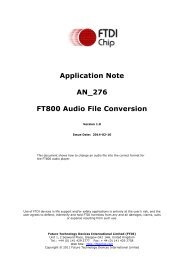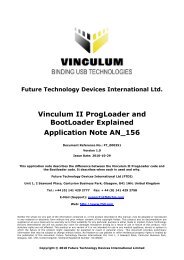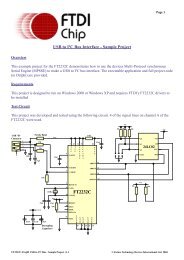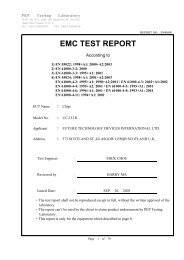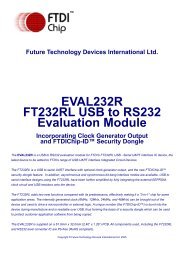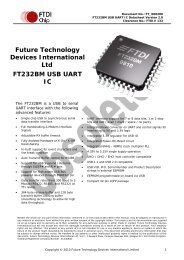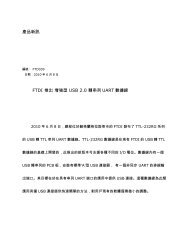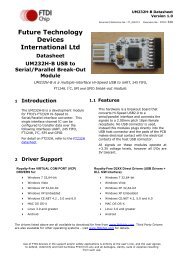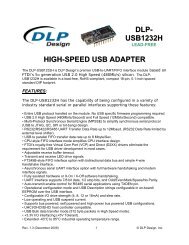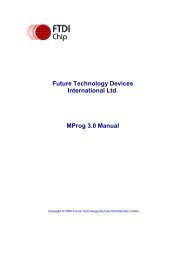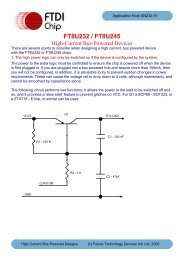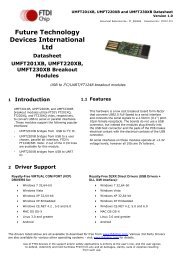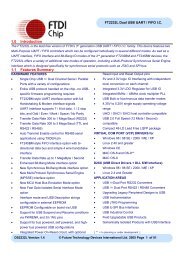You also want an ePaper? Increase the reach of your titles
YUMPU automatically turns print PDFs into web optimized ePapers that Google loves.
4.3 <strong>Aliasing</strong> Using the Additional Sub-Integer Divisors<br />
Document Reference No.: FT_000161<br />
<strong>Aliasing</strong> <strong>VCP</strong> <strong>Baud</strong> <strong>Rates</strong> Application Note AN_120<br />
Version 1.0<br />
Clearance No.: <strong>FTDI</strong># 122<br />
The standard <strong>FTDI</strong>PORT.INF ConfigData <strong>Baud</strong> rate table only supports the original FT8U232AM<br />
sub-integer prescalers and not the new ones added for the FT232B and subsequent devices. To allow the<br />
addition sub- integer prescalers to be used when aliasing a <strong>Baud</strong> rate the following ConfigData entry is<br />
needed:<br />
[FtdiPort232.NT.HW.AddReg]<br />
HKR,,ConfigData,1,11,00,3F,3F,10,27,00,00,88,13,00,00,C4,09,00,00,E2,04,00,00,71,02,00,00,38,<br />
41,00,00,9C,80,00,00,4E,C0,00,00,34,00,00,00,1A,00,00,00,0D,00,00,00,06,40,00,00,03,80,00,00,<br />
00,00,00,00,D0,80,00,00<br />
(Note - The current ftdiport.inf file contains both formats for the config data string. You select/disable the<br />
correct string by using a ; at the start of the line to comment out the one you do not want. Only one<br />
entry for Config Data should be used.)<br />
In this case each field consists of 4 bytes, ordered as follows: Byte0, Byte1, Byte2, Byte3. Bits 13<br />
through 0 denote the integer divisor while bits 16, 15 and 14 denote the sub-integer divisor, as<br />
follows:<br />
16,15,14 = 000 - sub-integer divisor = 0<br />
16,15,14 = 001 - sub-integer divisor = 0.5<br />
16,15,14 = 010 - sub-integer divisor = 0.25<br />
16,15,14 = 011 - sub-integer divisor = 0.125<br />
16,15,14 = 100 - sub-integer divisor = 0.375<br />
16,15,14 = 101 - sub-integer divisor = 0.625<br />
16,15,14 = 110 - sub-integer divisor = 0.75<br />
16,15,14 = 111 - sub-integer divisor = 0.875<br />
Note that this ConfigData entry is the same as before except that each field consists of 4 bytes<br />
instead of 2 bytes. The first highlighted byte in ConfigData is the Flags byte and format of the fields<br />
is determined by Bit4 of the Flags byte. In the example above, setting Flags byte to 11 means that<br />
Bit4 is set and 4 byte fields are being used.<br />
The divisor can be extracted for each entry in a few simple steps, as shown here for the entry<br />
35,40,01,00<br />
Step 1 - re-order the bytes: 35,40,01,00 => 00014035 Hex<br />
Step 2 - extract the sub-integer divisor; 16 = 1, 15 = 0, 14 = 1 => sub-integer = 0.625<br />
Step 3 - extract the integer divisor: 13:0 = 0035 Hex = 53 Dec<br />
Step 4 - combine the integer and sub-integer divisors: 53.625 Dec<br />
Step 5 - divide 3000000 by the divisor => 3000000/53.625 = 55944 baud<br />
The following lists the standard values and their respective baud rates.<br />
10,27,00,00 => divisor = 10000, rate = 300<br />
88,13,00,00 => divisor = 5000, rate = 600<br />
C4,09,00,00 => divisor = 2500, rate = 1200<br />
E2,04,00,00 => divisor = 1250, rate = 2,400<br />
71,02,00,00 => divisor = 625, rate = 4,800<br />
38,41,00,00 => divisor = 312.5, rate = 9,600<br />
9C,80,00,00 => divisor = 156, rate = 19,230<br />
4E,C0,00,00 => divisor = 78, rate = 38,461<br />
34,00,00,00 => divisor = 52, rate = 57,692<br />
1A,00,00,00 => divisor = 26, rate = 115,384<br />
0D,00,00,00 => divisor = 13, rate = 230,769<br />
06,40,00,00 => divisor = 6.5, rate = 461,538<br />
03,80,00,00 => divisor = 3.25, rate = 923,076<br />
00,00,00,00 => RESERVED<br />
D0,80,00,00 => divisor = 208.25, rate = 14406<br />
To alias a rate of 920k baud to the standard 56k baud menu option under windows:<br />
Copyright © 2009 Future Technology Devices International Limited 8



